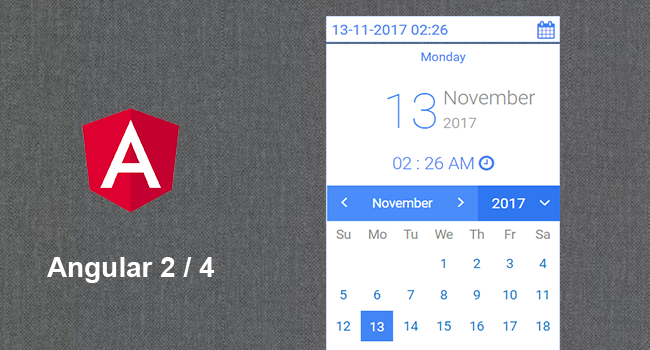
Overview
Angular 2 DateTimepicker is a cool responsive DateTimepicker component for Web and Mobile. It is Mobile friendly and light weight. Developed by Cuppa Labs.
Getting Started
To get started with using the multiselect dropdown component, follow the below steps. It’s easy to integrate and just a matter of minutes.
Installation
npm install angular2-datetimepicker
Usage
Import AngularDateTimePickerModule into your AppModule
import { AngularDateTimePickerModule } from 'angular2-datetimepicker';
@NgModule({
// ...
imports: [
AngularDateTimePickerModule,
]
// ...
})
Declare the component data variables and options in your component where you want to consume the dropdown component.
import { Component, OnInit } from '@angular/core';
export class AppComponent implements OnInit {
date: Date = new Date();
settings = {
bigBanner: true,
timePicker: false,
format: 'dd-MM-yyyy',
defaultOpen: true
}
constructor(){}
ngOnInit(){
}
}
Add the following component tag in the template where your want to place the datepicker
<angular2-date-picker [(ngModel)]="date" [settings]="settings"></angular2-date-picker>
Settings
Following settings object properties can be used to configure the component.
| Property | Type | Default | Description |
|---|---|---|---|
| format | String | dd-MMM-yyyy hh:mm a | Date format of the selected date. |
| bigBanner | Boolean | true | The banner section to show the date details. |
| defaultOpen | Boolean | false | To open the datepicker popover on load. Default is set to false. |
| timePicker | Boolean | false | Enable time picker feature. |
| closeOnSelect | Boolean | true | to close the popover on date select or on click of done button. |
Callback Methods
onDateSelect
Define a callback method to be called on select of the date.
<angular2-date-picker (onDateSelect)="onDateSelect($event)"
[(ngModel)]="date"
[settings]="settings" >
</angular2-date-picker>
Date Formats Support
format string can be composed of the following elements:
- ‘yyyy’: 4 digit representation of year (e.g. AD 1 => 0001, AD 2010 => 2010)
- ‘yy’: 2 digit representation of year, padded (00-99). (e.g. AD 2001 => 01, AD 2010 => 10)
- ‘y’: 1 digit representation of year, e.g. (AD 1 => 1, AD 199 => 199)
- ‘MMMM’: Month in year (January-December)
- ‘MMM’: Month in year (Jan-Dec)
- ‘MM’: Month in year, padded (01-12)
- ‘M’: Month in year (1-12)
- ‘LLLL’: Stand-alone month in year (January-December)
- ‘dd’: Day in month, padded (01-31)
- ‘d’: Day in month (1-31)
- ‘EEEE’: Day in Week,(Sunday-Saturday)
- ‘EEE’: Day in Week, (Sun-Sat)
- ‘HH’: Hour in day, padded (00-23)
- ‘H’: Hour in day (0-23)
- ‘hh’: Hour in AM/PM, padded (01-12)
- ‘h’: Hour in AM/PM, (1-12)
- ‘mm’: Minute in hour, padded (00-59)
- ‘m’: Minute in hour (0-59)
- ‘ss’: Second in minute, padded (00-59)
- ’s’: Second in minute (0-59)
- ‘sss’: Millisecond in second, padded (000-999)
- ‘a’: AM/PM marker
- ‘Z’: 4 digit (+sign) representation of the timezone offset (-1200-+1200)
- ‘ww’: Week of year, padded (00-53). Week 01 is the week with the first Thursday of the year
- ‘w’: Week of year (0-53). Week 1 is the week with the first Thursday of the year
- ‘G’, ‘GG’, ‘GGG’: The abbreviated form of the era string (e.g. ‘AD’)
- ‘GGGG’: The long form of the era string (e.g. ‘Anno Domini’)
format string can also be one of the following predefined localizable formats:
-
‘medium’: equivalent to ‘MMM d, y h:mm:ss a’ for en_US locale (e.g. Sep 3, 2010 12:05:08 PM)
- ‘short’: equivalent to ‘M/d/yy h:mm a’ for en_US locale (e.g. 9/3/10 12:05 PM)
- ‘fullDate’: equivalent to ‘EEEE, MMMM d, y’ for en_US locale (e.g. Friday, September 3, 2010)
- ‘longDate’: equivalent to ‘MMMM d, y’ for en_US locale (e.g. September 3, 2010)
- ‘mediumDate’: equivalent to ‘MMM d, y’ for en_US locale (e.g. Sep 3, 2010)
- ‘shortDate’: equivalent to ‘M/d/yy’ for en_US locale (e.g. 9/3/10)
- ‘mediumTime’: equivalent to ‘h:mm:ss a’ for en_US locale (e.g. 12:05:08 PM)
- ‘shortTime’: equivalent to ‘h:mm a’ for en_US locale (e.g. 12:05 PM)
Run locally
- Clone the repository or downlod the .zip,.tar files.
- Run
npm install - Run
ng servefor a dev server - Navigate to
http://localhost:4200/
License
MIT License.
Credits
Thanks to Font Awesome and Moment.js for the libraries.
Author
Pradeep Kumar Terli
